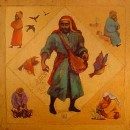Gospel Story: A Sower Went Out To Sow

The thirteenth chapter of Matthew’s Gospel introduces us to Jesus’s use of parables.
A parable is a wise saying or a fictitious short story used by Jesus to expound his teaching.
It leads the listener to concede a point that he himself does not immediately perceive as applicable to himself, so the lesson goes home.
Most of the parables used by Jesus come from his own life setting, so they were familiar to his listeners. Later on, the teachings of Jesus were modified by the early Christian community. We notice this when we compare the parables in their different Gospel versions.
One of the simplest and best loved parables is that of the Sower. It’s a simple description of the process of ploughing in Palestine, of the kind of ground on which the seed is sown, and of the usual results.
The “footpath” is the soil trodden hard in paths through the fields. Wild thorns, the most common weed in the country, are not cleared before ploughing, but are upturned during the act of ploughing itself. The fields are sown throughout, even at the edges where the limestone subsoil lies close to the surface.
The parable concludes with a reference to the yield of the crop, which varies depending on the quality of the soil where the seed was sown.
The ‘kingdom of heaven’ is the central point of the parable. The kingdom will arrive in spite of obstacles. The harvest will be there, in spite of the difficulties of growth. This is a real cause of hope.
Even in the early Church communities, not everyone yielded a bumper harvest. The results varied. So this parable is an image of the Church in growth.
- 7119 reads
 Printer-friendly version
Printer-friendly version

